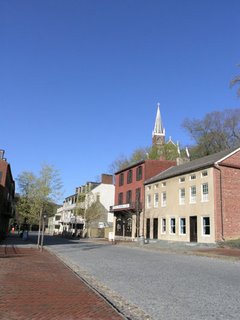 On the 11th we drove out to Harpers Ferry and then onto Antietam. Harpers Ferry is a very cool place. A good portion of it is preserved in its original condition, right down to the cobblestone streets. This is part of what the National Park Services Official Map and Guide to Harper’s Ferry Park says:
On the 11th we drove out to Harpers Ferry and then onto Antietam. Harpers Ferry is a very cool place. A good portion of it is preserved in its original condition, right down to the cobblestone streets. This is part of what the National Park Services Official Map and Guide to Harper’s Ferry Park says:“Understanding the Past
The history of Harpers Ferry has few parallels in the American drama. It is more than one event, one date, or one individual. It is multi-layered, involving a diverse number of people and events, decisions and actions that influenced the course of our nation’s history. Harpers Ferry witnessed the first successful application of interchangeable parts, the arrival of the first successful American railroad, John Brown’s attack on slavery, the largest surrender of Federal troops during the Civil War, and the education of former slaves in one of the earliest integrated schools in the United States.”
I tried to find a better way to explain the immense amount of history to have taken place in Harpers Ferry, but they summed it up better than I ever could have. http://www.nps.gov/hafe/ They have several of their buildings that are open as ‘living history’ displays. This means that they have restored the buildings to as close to what they would have looked like in 19th century as they could, they also have people dressed in period clothing to tell you about the history of the place and how life would have been then. It’s pretty cool.
From Harpers Ferry we drove to Antietam Battlefield. http://www.nps.gov/anti/ A handout we received from one of the
 Rangers has this to say about Harpers Ferry to Antietam (provided by the National Park Service, U.S. Department of Interior):
Rangers has this to say about Harpers Ferry to Antietam (provided by the National Park Service, U.S. Department of Interior):“Desperate Race”
On September 17, 1862, Confederate troops under General A.P. Hill raced desperately from Harpers Ferry toward Sharpsburg, MD. Their objective: to reinforce the Army of Northern Virginia near the banks of Antietam Creek. They reached their goal in late afternoon. Their help brought the Federal forces to a standstill. The confederate army escaped, and lived, to fight again.
Hill’s infantry completed their 17 mile march in less than 8 hours. Today you may drive from Harpers Ferry to Antietam in about thirty minutes. Along the way you will pass the battlefield of Schoolhouse Ridge, where Stonewall Jackson’s brilliant maneuvers forced the Union garrison’s quick surrender.”
And that was just the drive between the two places, Antietam Battlefield itself is incredible. The stories and talks that the Rangers tell are really worth listening to, be sure to stop first at the visitor center to catch the film they have then take in one of the Ranger talks before you drive the battlefield.
Probably the story that sticks out the most for me is either the one about having to drill holes in the church floor, being used as a hospital, to let the blood that was starting to puddle and run like rivers on the floor, or the story about the soldier who crossed the sunken road not knowing it was the sunken road. He also didn’t know it was bodies he was walking across. There are parts of the sunken road that are deeper than I am tall and the road was stacked so high with bodies that it didn’t look like it was sunken at all.
It’s pretty incredible to stand in these places and to be able to picture in your head what the different Armies were up against at different times and in different places. It goes back and forth, you stand on the Union side, then move over to the confederate side and at different times and in different places you have to wonder what some of these General’s were thinking.
That’s it for this post, I’m really behind and trying to catch up, my internet connection isn’t great and sometimes doesn’t work, so I’m getting this stuff in as I can.
;-)K